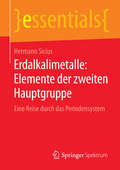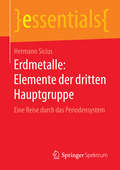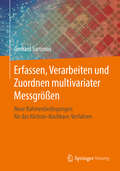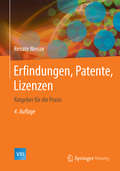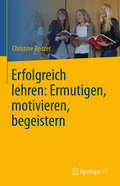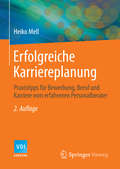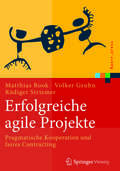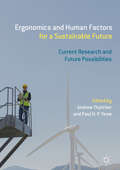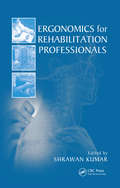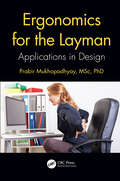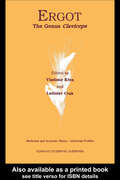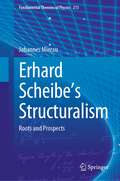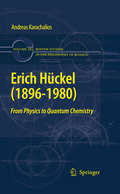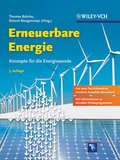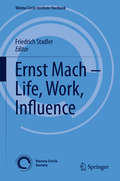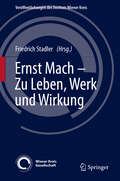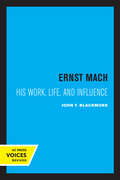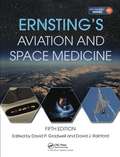- Table View
- List View
Erdalkalimetalle: Eine Reise durch das Periodensystem (essentials)
by Hermann SiciusHermann Sicius stellt die Elemente der zweiten Hauptgruppe des Periodensystems, die Erdalkalimetalle, mit ihren wichtigsten Eigenschaften und Anwendungsgebieten vor. Die Elemente dieser Gruppe - Beryllium, Magnesium, Calcium, Strontium, Barium und Radium - sind zwar sämtlich Metalle, zeigen aber deutliche Abstufungen ihrer Charakteristika und überraschende Eigenheiten: Beryllium ist durchlässig für Röntgenstrahlen und Barium aus derselben Gruppe nicht; Beryllium- und Bariumverbindungen sind sehr giftig, Calcium- und Magnesiumverbindungen für uns dagegen lebensnotwendig. In diesem Essential erfahren Sie alles Wichtige über diese interessante Hauptgruppe.
Erdmetalle: Eine Reise durch das Periodensystem (essentials)
by Hermann SiciusDieses Essential bietet eine prägnante und umfassende Übersicht über die Elemente der dritten Hauptgruppe des Periodensystems, auch Borgruppe oder Erdmetalle genannt. Alle Elemente dieser Gruppe, mit Ausnahme des vor etwa zehn Jahren erstmals erzeugten Ununtriums, wurden erst im 19. Jahrhundert entdeckt. Obwohl Aluminium das am häufigsten vorkommende Metall ist, blieb es in elementarer Form lange verborgen. Gallium, Indium und Thallium sind dagegen sehr selten. Die Elemente dieser Gruppe ändern ihren Charakter teils stark von Halbmetall (Bor) über das allgegenwärtige Aluminium hin zu tiefschmelzenden Schwermetallen (Gallium, Indium und Thallium) und zu einem möglicherweise leichtflüchtigen und gelegentlich anionisch auftretenden Metall (Ununtrium).
Erfassen, Verarbeiten und Zuordnen multivariater Messgrößen: Neue Rahmenbedingungen für das Nächste-Nachbarn-Verfahren
by Gerhard SartoriusDas Buch gibt einen Überblick zu verschiedenen Verarbeitungsmethoden zur Klassifizierung von Messgrößen und den dazu benötigten Techniken. Mit verschiedenen Beispielen wird allgemein verständlich die Arbeitsweise der vorgestellten Module erläutert. Dabei werden methodenbedingte Spielräume hervorgehoben und der Bezug zu Anwendungen hergestellt, um dem Leser zu ermöglichen, die für eine Anwendung optimale Lösung zu finden. Die Bereitstellung neuer Rahmenbedingungen ermöglicht es, multivariate Messgrößen hochpräzise und ohne Eingabe von Parametern durchzuführen. Die Berechnungen werden mit den Programmpaketen MatLab und Excel durchgeführt. Dabei wird besonderer Wert auf die Nachvollziehbarkeit der zentralen Rechenoperationen gelegt.
Erfindungen, Patente, Lizenzen: Ratgeber für die Praxis (VDI-Buch)
by Renate WeisseDieser Ratgeber behandelt die häufigsten Fragen in der patentanwaltlichen Erstberatung. Woran erkenne ich eine Erfindung? Wie kann ich meine Ideen schützen? Welche Rechte und Pflichten hat ein Arbeitgeber und ein Arbeitnehmererfinder? Was muss ich tun um internationalen Schutz für meine Innovationen zu erhalten? Wie recherchiere ich nach Schutzrechten und wie vermeide ich eine Schutzrechtsverletzung? Neben den Fragen des Patent- und Gebrauchsmusterrechts werden auch die Möglichkeiten des Marken- und Designschutzes dargestellt. Der Ratgeber gibt viele praxisrelevante Tipps und hilft bei kostenintensiven Entscheidungen.
Erfolgreich abnehmen und schlank bleiben: Nachhaltige Gewichtsreduktion wissenschaftlich belegt
by Uwe KnopDieses Sachbuch möchte allen eine ehrliche Unterstützung bieten, die ernsthaft abnehmen und ihr neues Wunschgewicht auch langfristig halten möchten. Denn: Es ist unbestritten, dass viele Frauen und Männer abnehmen wollen, und sie machen Diäten. So werden jedes Jahr aufs Neue viele Abnehmwillige mit falschen Versprechungen zur neuen„besten Diät“ hinters Licht geführt. Dieses Sachbuch geht erstmals einen anderen Weg: I DIET MY WAY - ist das neue Konzept für alle, die ihren individuellen Weg des Abnehmens maßgeschneidert bis zu ihrem persönlichen Wohlfühlgewicht gehen möchten – und anschließend dabei bleiben wollen. In diesem Buch finden Sie alles zum Thema "Kilos verlieren", was Sie wissen müssen, um langfristig abzunehmen und Ihr Wunschgewicht auch zu halten. Dabei basieren die Erkenntnisse und Empfehlungen vom Autor Uwe Knop auf den aktuellen Erkenntnissen und dem derzeitigen Konsens der WissenschaftLeicht verdaulich und unterhaltsam erfahren Sie in diesem Buch: Abnehmen ist möglich.Das Diätprinzip ist bei allen Diäten immer gleich.Das reduzierte Gewicht zu halten, ist die „hohe Kunst“. JoJo-Effekt & Co: Risiken, die Ihr Gewicht ins Schwanken bringenPraxistipps, wie Sie starten und dran bleiben Sie möchten erfolgreich abnehmen und dauerhaft schlank bleiben? Dann lesen Sie dieses Buch.
Erfolgreich lehren: Ermutigen, motivieren, begeistern
by Christine ReitzerUnmotiviertes Lernverhalten und abgelenkte Studenten stellen für Lehrende wie für Lernende ein zentrales Problem im Unterricht dar. In diesem Buch wird sowohl etabliertes psychologisches Wissen wie auch Erkenntnisse aus persönlichen Umfragen nutzbar gemacht, um diesem Phänomenen unserer Zeit gezielter begegnen zu können. Sie müssen nicht "ein geborener Lehrer" sein um Ihre Lehre ansprechend zu gestalten. Dieses Werk zeigt eine Fülle von Maßnahmen auf, die Sie für die Praxis berücksichtigen und dadurch Ihre Lehrtätigkeit noch erfolgreicher und effektiver gestalten können.Der Schwerpunkt liegt in diesem Werk auf ermutigenden Ideen, ansprechendem Unterrichtsklima, intrinsischen Motivationsmethoden und professioneller Gesprächsführung. Diese Punkte können Sie als Leser einfach umsetzen, ohne große Programme bemühen zu müssen. Hierzu werden effektive Grundkonzepte vorgestellt, die anhand von Fallbeispielen präzisiert werden. Diese werden abgerundet durch konkrete, praxistaugliche Tipps für typische Alltagssituationen. Diese praxisnahen Hilfestellungen eignen sich für den Unterricht bzw. die Lehre in verschiedenen Wissenschaftszweigen und dienen zur Motivation der Teilnehmer. Dabei schöpft die Autorin aus ihrem eigenen internationalen Erfahrungsschatz sowie aus dem Fundus von vielen weltweit erfahrenen Lehrenden, die sich an den Umfragen beteiligt haben.Zielgruppen für dieses Werk sind alle, die lehren oder sich auf ihre Lehrtätigkeit vorbereiten möchten.
Erfolgreich wissenschaftlich arbeiten: Alles, Was Studierende Wissen Sollten
by Steffen Stock Patricia Schneider Elisabeth Peper Eva MolitorDie Autoren vermitteln in diesem Buch Techniken, mit denen sich alle Prüfungsformen im Rahmen des Studiums meistern lassen. Zu den Instrumenten gehören Lese- und Schreibtechniken sowie die gezielte Vorbereitung auf Referate. Hochschuldozenten selbst schildern in dem Band, was sie von den Studenten erwarten. Der interdisziplinäre Ratgeber präsentiert das geballte Wissen vieler Hochschulabsolventen und ist für Studierende aller Disziplinen geeignet.
Erfolgreiche Karriereplanung: Praxistipps für Bewerbung, Beruf und Karriere vom erfahrenen Personalberater (VDI-Buch)
by Heiko MellNeu und umfassend bearbeitet präsentiert das Buch nun auch ein sorgfältig gestaltetes Konzept zur Durchführung einer Karriereplanung. Aus der Erfahrung langer praktischer Beratung entstanden, methodisch aufgebaut und mit leicht nachvollziehbaren Begründungen für die Details, bieten diese Ausführungen einen wertvollen Handlungsleitfaden für die erfolgreiche Berufstätigkeit. Weiterhin enthalten bleiben der neu bearbeitete praktische Teil mit konkreten Beispielen, Fragen und Antworten aus der Karriereberatung, bekannt u.a. aus den VDI Nachrichten. Diese Beiträge sind thematisch zusammengefasst und geordnet. Auch beibehalten und neu bearbeitet wurde der Karrierepotenzialtest, ein vom Autor entwickeltes, vielfältig in der Praxis bewährtes Werkzeug zum Selbsttest. Der Test gibt belastbare Hinweise auf die Voraussetzungen, die der karriereinteressierte Leser selber mitbringt. Gleichzeitig erweitert er das Verständnis für wichtige Fragestellungen der Karriereplanung.
Erfolgreiche agile Projekte: Pragmatische Kooperation und faires Contracting (Xpert.press)
by Matthias Book Volker Gruhn Rüdiger StriemerDas Buch beschreibt pragmatische Instrumente und Methoden, die Software-Entwicklern und Fachexperten dabei helfen, ein gemeinsames Problem- und L#65533;sungsverst#65533;ndnis zu entwickeln und Projekte so zu managen, dass Risiken fair zwischen Auftraggeber und Auftragnehmer verteilt werden. Teil 1 beleuchtet kurz die agile Entwicklungspraxis im kommerziellen Umfeld. Teil 2 beschreibt den Interaction Room, in dem Entwickler und Fachexperten auf gleicher Augenh#65533;he zusammenarbeiten. Teil 3 beschreibt das Preis- und Vertragsmodell adVANTAGE, das die Br#65533;cke zwischen agiler Philosophie und vertraglich fixierten Leistungserwartungen schl#65533;gt. Teil 4 illustriert die Methoden am Beispiel einer industriellen Fallstudie, bevor Teil 5 ein modernes Qualifikationsprofil aufstellt. Das Buch wendet sich an CIOs, Projektmanager und Entwickler, die Risiken in ihren Projekten fr#65533;her erkennen, souver#65533;ner mit der Ungewissheit komplexer Projekte umgehen und effektiver mit Kunden bzw. Dienstleistern kooperieren wollen.
Ergonomic Workplace Design for Health, Wellness, and Productivity (Human Factors and Ergonomics)
by Alan HedgeEven with today’s mobile technology, most work is still undertaken in a physical workplace. Today’s workplaces need to be healthy environments that minimize the risks of illnesses or injuries to occupants to compete in the marketplace. This necessitates the application of good ergonomics design principles to the creation of effective workplaces, and this is the focus of this book. This book will:· Focus on ergonomic design for better health and ergonomic design for better productivity· Presents environments that support new ways of working and alternative workplace strategies, as well as the impacts of new technologies· Covers the role of ergonomics design in creating sustainable workplaces· Includes ergonomics design for a wide variety of workplaces, from offices to hospitals, to hotels to vehicles, etc…· Shows the design principles on how to design and create a healthy and productive workplace The market lacks an ergonomics design book that covers the topics that this book will cover. This book summarizes design principles for practitioners, and applies them to the variety of workplace settings described in the book. No other book currently on the market does that.
Ergonomics and Human Factors for a Sustainable Future: Current Research And Future Possibilities
by Andrew Thatcher Paul H.P. YeowThis book focuses on different sustainable products and services, such as electrical vehicles, green buildings, and biophilic and biomimetic systems, at multiple hierarchical levels within its chapters. The authors reflect on individual, organisational, governmental, political, and moral considerations of how Human Factor Ergonomics can build a sustainable future. This book is a must-read for anyone concerned with environmental issues and sustainability.
Ergonomics for Rehabilitation Professionals
by Shrawan KumarDespite the apparently distinct differences between the disciplines of ergonomics and rehabilitation, they deal with the same issues, although at different ends of the spectrum. Keeping this in mind, Ergonomics for Rehabilitation Professionals explores their philosophies and goals, their parallel, divergent, and complementary aspects. It traces the
Ergonomics for the Layman: Applications in Design
by Prabir MukhopadhyayThis book explains the application of ergonomics in three different areas of design, namely product, space, and communication. The book is written in layman's language and provides examples so that the reader can easily apply the principles to their designs. This book is easy to understand for those without a background in science and technology. It provides a guide for designers from diverse fields ranging from product design to graphic design and shows how to apply ergonomic principles in products from hand-held products to larger products. It explains the application of anthropometric dimensions, as well as how to design for different spaces ranging from bathrooms to cinema halls. It also focuses on the application of communication ranging from displays to graphic design and discusses the significance of color selection. This book is ideal for all design students, practicing designers in any field, design faculty, entry-level engineering students, and anyone who is interested in exploring the field of ergonomics. Features Specifically written in such a way to make it easily understood for those not educated in the field Shows how to apply the ergonomic principles in design Provides an overview of the topic of ergonomics Written in a storytelling format
Ergot: The Genus Claviceps (Medicinal and Aromatic Plants - Industrial Profiles)
by Vladimir Kren Ladislav CvakThis volume provides readers with biotechnological aspects of ergot alkaloid production and genetic and physiological data. Toxicology and environmental risks of ergot infection and contamination of food and forage are also detailed
Erhard Scheibe's Structuralism: Roots and Prospects (Fundamental Theories of Physics #213)
by Johannes MierauThis book offers the first systematic review of the structuralism of physical theories. Particular emphasis is placed on the inclusion of empirical imprecision into formal reconstructions of theories. The proposed measure of imprecision allows for a topological comparison of theories. Considering the ongoing debates on the nature of the thermodynamic limit in statistical mechanics, as well as on limit relations between classical and quantum mechanics, the author asserts that the Bourbaki-style structuralism, together with E. Scheibe's theory of reduction, is the best choice for reconstructing and analyzing the related questions of reduction and emergence. Readers will appreciate the critical overview of the main positions in philosophy of science, examined with particular attention to their applicability to current problems of fundamental theories of physics.
Erich Hückel (1896-1980)
by Andreas KarachaliosThis study, the first comprehensive account of Erich Hückel's career, examines his scientific work as well as his importance for the emergence of quantum chemistry as an independent discipline in Germany during the 1930s. Hückel began his career by studying quantum physics in Göttingen, but his background in chemistry led him to take up pioneering research on the physics of chemical bonding. Drawing on a variety of sources, Andreas Karachalios offers a probing account of fast-breaking developments in quantum theory that paved the way for Hückel's research. In Göttingen and later in Leipzig, Hückel interacted with leading figures not only in quantum physics and physical chemistry but also with others in nearby fields, including organic chemistry and mathematics. During his later career in Marburg, Hückel clashed with Linus Pauling over the properties of the benzine molecule. In order to appreciate this controversy, Karachalios gives a brief account of the mathematical formalism of spin invariants, with both Hückel and Pauling used in their analyses, though with different interpretations. This serves not only to clarify their differences but also to illustrate the importance of the quantum-mechanical theory of resonance for chemistry at this time.
Ernest Nagel: Philosophy of Science and the Fight for Clarity (Logic, Epistemology, and the Unity of Science #53)
by Matthias Neuber Adam Tamas TubolyThis volume is dedicated to the life and work of Ernest Nagel (1901-1985) counted among the influential twentieth-century philosophers of science. Forgotten by the history of philosophy of science community in recent years, this volume introduces Nagel’s philosophy to a new generation of readers and highlights the merits and originality of his works.Best known in the history of philosophy as a major American representative of logical empiricism with some pragmatist and naturalist leanings, Nagel’s interests and activities went beyond these limits. His career was marked with a strong and determined intention of harmonizing the European scientific worldview of logical empiricism and American naturalism/pragmatism. His most famous and systematic treatise on, The Structure of Science, appeared just one year before Thomas Kuhn’s even more renowned, The Structure of Scientific Revolutions. As a reflection of Nagel’s interdisciplinary work, the contributing authors’ articles are connected both historically and systematically. The volume will appeal to students mainly at the graduate level and academic scholars. Since the volume treats historical, philosophical, physical, social and general scientific questions, it will be of interest to historians and philosophers of science, epistemologists, social scientists, and anyone interested in the history of analytic philosophy and twentieth-century intellectual history.
Ernest Thompson Seton: Scout and Naturalist
by Wyatt BlassingameThis naturalist and artist learned much from the Indians, and he wanted to share his knowledge with boys, so that they would love and protect wildlife. Other books by this author are available in this library.
Erneuerbare Energie: Konzepte für die Energiewende
by Herausgegeben VonLeading scientists explain photovoltaics, solar thermal energy, solar air-conditioning, wind and hydroelectric power, fuel cells, energy-efficient buildings, and hydrogen storage for stabilizing networks. Contains about 20% more information than the second edition.
Erneuerbare Energien
by Andreas Wiese Martin Kaltschmitt Wolfgang StreicherDieses Standardwerk stellt die physikalisch-technischen Grundlagen und die aktuelle Systemtechnik für Anlagen zur Nutzung regenerativer Energien zur Strom- und Wärmebereitstellung dar. Außerdem gibt es einen umfassenden Überblick über die Charakteristik des erneuerbaren Energieangebots. Ausgehend davon werden Kennzahlen für eine ökonomische und ökologische Bewertung zugänglich gemacht und die Potenziale der regenerativen Energien und deren derzeitige Nutzung in Deutschland diskutiert. Im Einzelnen werden die folgenden Optionen zur Nutzung des regenerativen Energieangebots aufgezeigt: - passive Solarenergienutzung, - solarthermische Wärmebereitstellung, - photovoltaische und solarthermische Stromerzeugung (u. a. Solarfarm- und Solarturmkraftwerke), - Stromerzeugung aus Windenergie und Wasserkraft, - Wärmebereitstellung mithilfe von Wärmepumpen aus Umgebungsluft und oberflächennaher Erdwärme, - Strom- und Wärmebereitstellung aus der Energie des tiefen Untergrunds. Zusätzlich werden kursorisch die Möglichkeiten einer Nutzung der Meeresenergien dargestellt. Nicht diskutiert wird dagegen die Energiegewinnung aus Biomasse. Für die 5. Auflage wurden u. a. die photovoltaische Stromerzeugung vollständig aktualisiert, die passive und aktive solarthermische Wärmegewinnung umfassend überarbeitet, die Windkraftnutzung einschließlich der Offshore-Windstromerzeugung dem aktuellen Stand der Technik angepasst und die Möglichkeiten einer geothermischen Strom- und Wärmeerzeugung neu strukturiert dargestellt. Außerdem wurden die Grundlagen des regenerativen Energieangebots erweitert. Neben seiner Eignung für die universitäre und außeruniversitäre Lehre bietet das Buch Entscheidungsträgern in Energiewirtschaft, Politik, Verwaltung und Administration sowie Wissenschaftlern und Beratern eine fundierte, verlässliche und hochaktuelle Wissensbasis.
Ernst Mach – Life, Work, Influence (Vienna Circle Institute Yearbook #22)
by Friedrich StadlerThis edited volume features essays written in honor of Ernst Mach. It explores his life, work, and legacy. Readers will gain a better understanding of this natural scientist and scholar who made major contributions to physics, the philosophy of science, and physiological psychology. The essays offer a critical inventory of Mach’s lifework in line with state-of-the-art research and historiography. It begins with physics, where he paved the way for Einstein’s Theory of Relativity. The account continues with Mach's contributions in biology, psychology, and physiology pioneering with an empiricist and gestalthaft Analysis of Sensations. Readers will also discover how in the philosophy of science he served as a model for the Vienna Circle with the Ernst Mach Society as well as paved the way for an integrated history and theory of science. Indeed, his influence extends far beyond the natural sciences -- to the Vienna Medical School and psychoanalysis (R. Bárány, J. Breuer, S. Freud), to literature (Jung Wien, R. Musil), to politics (F. Adler, Austro-Marxism and the Viennese adult education), to arts between Futurism and Minimal Art as well as to social sciences between the liberal school (J. Schumpeter, F. A. von Hayek) and empirical social research (P. Lazarsfeld und M. Jahoda).
Ernst Mach – Zu Leben, Werk und Wirkung (Veröffentlichungen des Instituts Wiener Kreis #29)
by Friedrich StadlerErnst Mach (1838–1916) zählt zu den bedeutendsten Naturwissenschaftlern und Philosophen des 19. und 20. Jahrhunderts. In der Physik gilt er als Wegbereiter von Einsteins Relativitätstheorie und Kontrahent von Boltzmanns Atomistik. In der Biologie, Psychologie und Physiologie wird er als Pionier einer empiristischen und gestalthaften „Analyse der Empfindungen“ betrachtet. In der Wissenschaftsphilosophie schließlich war er Vorbild des Wiener Kreises mit dem Verein Ernst Mach und Wegbereiter einer integrierten Wissenschaftsgeschichte und Wissenschaftstheorie.Der Band versammelt die deutschsprachigen Beiträge zum Symposium anlässlich des 100. Todestages von Ernst Mach. Im Mittelpunkt der internationalen Konferenz im Juni 2016 an der Universität Wien und der Österreichischen Akademie der Wissenschaften standen Leben, Werk und Wirkung des Naturforschers und Philosophen. Der Band bietet eine kritische Bestandsaufnahme von Machs Lebenswerk vor dem Hintergrund der aktuellen Forschung und Historiografie.Die Autoren untersuchen unter anderem• seine Bedeutung für die Herausbildung einer naturwissenschaftlichen Psychologie• Machs historisch-kritische Methode• die Rolle der Kinematographie• die Rezeption durch Aleksander Bogdanov• das Verhältnis zu Sigmund Freuds Psychoanalyse Der Band erscheint in der Reihe „Veröffentlichungen des Instituts Wiener Kreis“ und richtet sich an Forschende auf den Gebieten der Wissenschaftsphilosophie, -geschichte und -theorie sowie der Kulturwissenschaften und der Wahrnehmungspsychologie.
Ernst Mach: His Life, Work, and Influence
by John T. BlackmoreThis title is part of UC Press's Voices Revived program, which commemorates University of California Press’s mission to seek out and cultivate the brightest minds and give them voice, reach, and impact. Drawing on a backlist dating to 1893, Voices Revived makes high-quality, peer-reviewed scholarship accessible once again using print-on-demand technology. This title was originally published in 1972.
Ernsting's Aviation And Space Medicine
by David DavidErnsting's Aviation and Space Medicine applies current understanding in medicine, physiology and the behavioural sciences to the medical challenges and stresses that are faced by both civil and military aircrew, and their passengers, on a daily basis. <p><p> The fifth edition of this established textbook has been revised and updated by a multi-disciplinary team of experienced contributors, and includes new chapters on space physiology and medicine, passenger safety, rotary wing operation by land and sea, and UAVs. It remains the recommended textbook for those studying for the Diploma in Aviation Medicine of the Faculty of Occupational Medicine of the Royal College of Physicians, recognized worldwide as a standard in the field, and for similar overseas qualifications. <p> Ernsting's Aviation and Space Medicine remains an essential companion for all civil and military aviation medicine practitioners, both when preparing for professional examinations and in daily practice, and for those in the many disciplines of the behavioural and life sciences that include some study of aviation, its physiology and related issues. It is also recommended reading for those with a wider interest in the medical problems of professional or recreational flying, air transport and the aviation industry.
Ernährung - Physiologische und Praktische Grundlagen
by Wim WätjenWas geschieht mit den verzehrten Lebensmitteln im Körper? Welche Nährstoffe brauchen wir in welchem Lebensalter, und kann Nahrung auch schädlich sein? Das Lehrbuch gibt einen umfassenden Überblick über die ernährungsphysiologischen Grundlagen, die zum erfolgreichen Bestehen eines ernährungswissenschaftlichen Studiums erforderlich sind. Kurze einführende Beispiele eröffnen die Kapitel und werfen so wichtige Fragen auf, die im weiteren Verlauf aufgegriffen werden. Zahlreiche Abbildungen und Kurzzusammenfassungen erleichtern das Lernen und die Prüfungsvorbereitung. Das Lehrbuch beschreibt auf anschauliche Weise, wie Nährstoffe aufgenommen werden, welche Funktionen sie im Körper haben und welcher Regulation sie unterliegen. Weitere Kapitel befassen sich mit den verschiedenen Methoden der Ernährungserhebung und den besonderen Nährstoffbedürfnissen von Menschen im Laufe ihres Lebenszyklus sowie mit der Ernährungstoxikologie. Das Lehrbuch greift in einzigartiger Weise auch die vorgeburtliche Ernährung auf und behandelt, wie wir Nahrungsmittel schmecken und riechen, wie die Gefühle von Hunger und Sättigung entstehen und welche Inhaltsstoffe von Lebensmitteln uns schaden.
